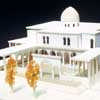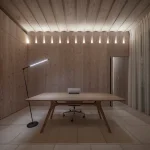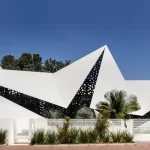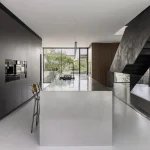Maimonides Central Sepharadi Synagogue, Israel, Architecture, Image, Proposal
Maimonides Central Sepharadi Synagogue : Design
Religious Building Project – design by Nili Portugali, Architect
17 Jan 2009
Maimonides Central Sepharadi Synagogue Building
Location: Hadera, Israel
Competition Entry – First Prize
Design: Nili Portugali
Hadera Synagogue Building
The idea behind the design of the central Sephardic synagogue was to attempt to revive traditional design patterns based on both Maimonides’ halachic rulings (the laws he set down in his book Hayad Hahazaka) and Talmudic literature as it was passed on to me by the beadles of the synagogues in Safad, capital of the Galilee, home and birthplace of Judaism’s mystical stream of the Kabbala, and infuse into them a new meaning, in line with the program for this synagogue, and in accordance with the immediate landscape.
I endeavored to captivate in this building the timeless spiritual exaltation that we experience in places of worship of every religion, in any culture we know, a feeling that worshippers underwent in synagogues where Maimonides prayed, such as the Iben Denan Synagogue in Fez, Morocco, the Ben-Ezra Synagogue in Cairo, Egypt, or the Abuhab Sephardic Synagogue in Safad, Israel. That deep feeling that opens your heart when entering places of worship, stems from the structural properties of the building itself.
The courtyard at the front of the building forms a transition area, separating that which is holy from the secular. Access to the courtyard is via a wide staircase, located in between two existing eucalyptus trees “to exalt the house of the Lord.” The gates at the entrance to the courtyard are the “Gates of Prayer”. At the courtyard’s center of gravity is a water fountain; water being the symbol of life in all religions.
At the main entrance door to the building there is a stair leading down into the synagogue, as it says, “From the depths I call to thee, Oh Lord.”
The synagogue seats 450 worshippers, 300 men in the main hall and 150 in the women’s section. The wall of the Holy Ark (which holds the Torah scrolls) faces Jerusalem. In the center of the hall there are four pillars, corresponding to the number of the “Matriarchs”, structurally dividing the hall into 9 sections, corresponding to the nine months of pregnancy.
The Sephardic synagogue had its roots in the Eastern culture of the Islamic lands and thus was influenced by the structure of the mosque. The seats (as in mosques) are arranged around the walls, perpendicular to and at an equal distance from the axis that links the Holy Ark and the “bimah” (dais), where the reader of the Torah portion stands.
The “bimah” stands on 8 pillars, equal to the 8 days of Hanukah. Over the “bimah” there is a dome with 12 windows, representing the Twelve Tribes. The building is constructed of white plaster incorporated with regionally quarried sandstone used for the frames of the doors and windows, the arches of the arcade and the floor tiles of the courtyard.
Nili Portugali is a practicing architect working in Israel for more than 30 years teaching at the Faculty of Architecture and Town Planning, Technion, Israel Institute of Technology, Haifa (until 2006 at the Bezalel Academy of Art & Design, Architectural Department, Jerusalem). Her work has focused on both practice and theory, and is tightly connected to the holistic-phenomenological school of thought.
She is a graduate of the Architectural Association School of Architecture (A.A), London (Diploma 1973). She studied architecture and Buddhism at the University of California, Berkeley, U.S.A (1979-81), and worked and participated in research with Prof. Christopher Alexander at the Center for Environmental Structure, Berkeley California.
Portugali has won prizes in competitions; she is invited to lectures in international conferences and participates in various exhibitions in Israel and abroad. She has published many articles on architecture and her work is documented in professional magazines, in the press and on television. She was Member of Special Committee for the authorization of schools of Architecture in Israel at the Council for Higher Education.
She has just published her new book which was selected among the 24 books of the year 2007 by the Royal Institute of British Architects International Book Award
The Act of Creation and the Spirit of a Place
A Holistic- Phenomenological Approach to Architecture
/Axel Menges Stuttgart-London 2006
For More details on Nili Portugali’s work & Book see: www.niliportugali.com
Maimonides Central Sepharadi Synagogue image / information from Nili Portugali Jan 09
Location: Hadera, Israel
Israel Architecture
Contemporary Architecture in Israel
Israeli Architecture Designs – chronological list
Church of the Holy Sepulchre Jerusalem
Jerusalem Architecture Walking Tours
The Ada and Tamar House, near Tel-Aviv
Design: Amos Goldreich Architecture
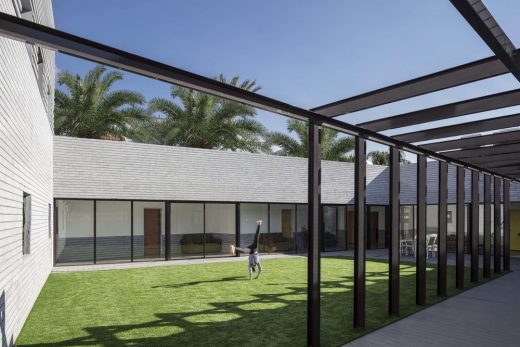
photograph : Amit Gosher
Shelter for Victims of Domestic Violence near Tel-Aviv
Kofinas Information Centre, Tzur Moshe
Design: Ron Shenkin Studio

photograph : Shai Epstien
Kofinas Information Centre in Tzur Moshe
Tel Aviv Architecture Walking Tours
Ashkelon Music and Dance Center
Peace Peres House, Jaffa, central Israel
Massimiliano & Doriana Fuksas Architects
Peace Peres House Jaffa
Comments for the Maimonides Central Sepharadi Synagogue Israel page welcome

